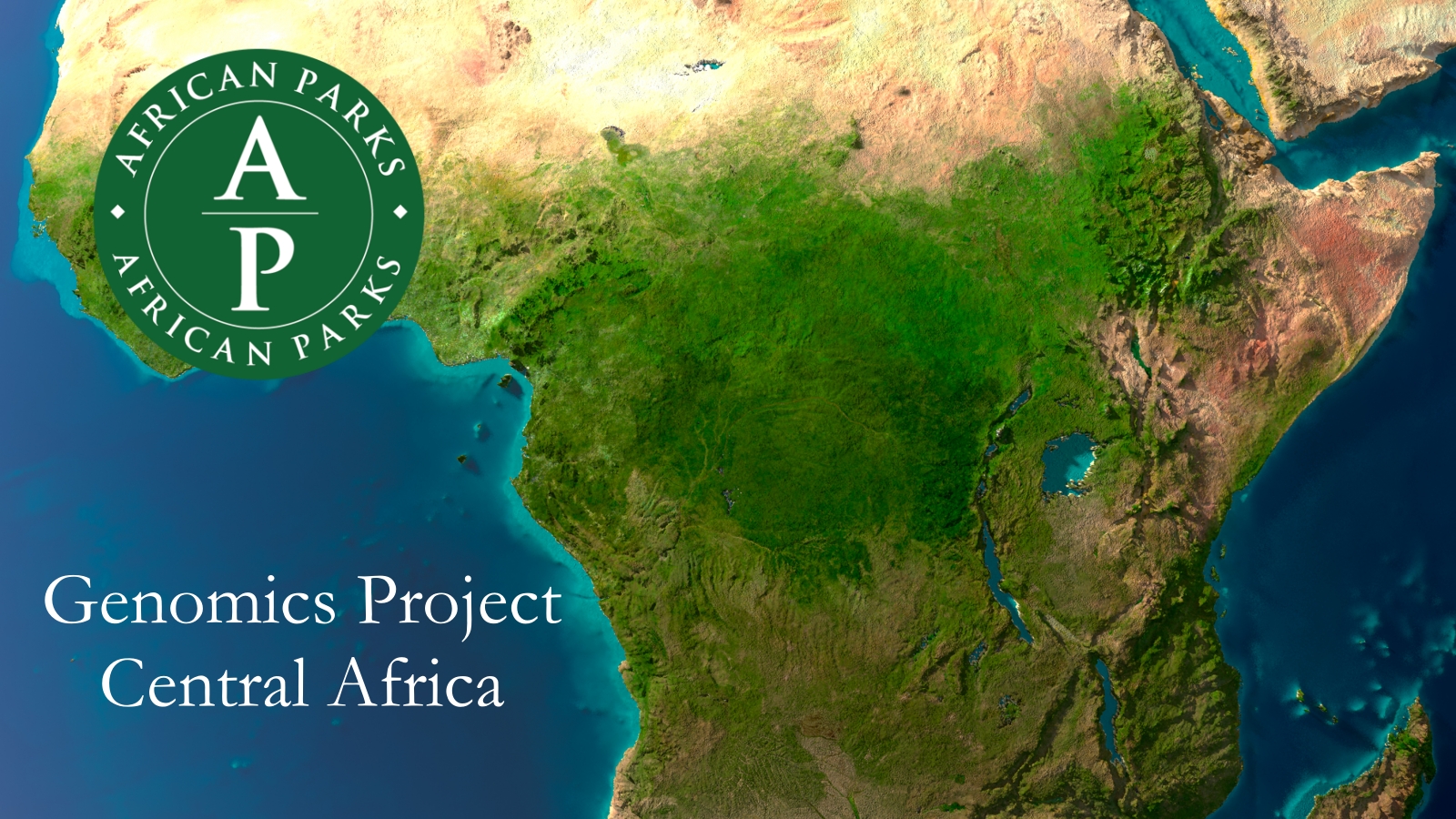Project: Genomic Reference Work in the Garamba Complex – the collection of data and its genomic analysis by Stanford University, USA.
2020 fund-raising target: US$ 25,000
2020 donation: $28,500 USD

Explorers Against Extinction has partnered with Garamba National Park, DRC and African Parks in a far-reaching Genome Project being carried out by Stanford University in California USA.
The project focuses on elephants, giraffes, carnivores (primarily, lions, leopards and hyenas) and chimpanzees. There is scope within the project parameters to include other forest species within the study.
Conservation areas in Central and Western Africa are vast, remote and often in politically challenging and physically dangerous locations. It is impossible, even with today’s technology, to accurately survey the populations and ecosystems that exist in these wildernesses. There is too much ground to cover – wildlife moves and migrates, or is hidden entirely, preventing accurate survey results. Much of the terrain comprises forest or bush with thick cover, unsuitable for air reconnaissance. There is little of no infrastructure such as roads or tracks and few bridges across major rivers. To understand the scale of these areas, please read about the specific parks involved in the study below.
As a conservationist, how do you know which species are most threatened and which ecosystems are most under threat? Which creatures have viable and healthy populations? Do those populations interact with each other or are they genetically isolated? Are there populations out there we don’t know about, hidden in this vast wilderness? Are there areas that should be prioritised for conservation due to their biodiversity?
Answer these questions and you can create a comprehensive and accurate conservation strategy. You know which species are struggling and which are surviving. You can tailor your resources to get optimum results for your efforts. Build up a comprehensive and convincing overview and you can attract large-scale funding to secure vast areas of wilderness for animal conservation.
“Genomics has the potential to add a whole new dimension to our understanding of wildlife and how best to manage, and protect it. In the near future, even in the most remote parts of the Congo, a single sample of dung or tissue will be able to contribute to big data sets, help us better understand demographics, contribute to population viability assessments and produce other conservation tools. One of the most exciting uses will be in employing this for the more cryptic species of wildlife, whose natural history places them beyond the reach of more traditional methods of learning.”
Naftali Honig
Director of Research and Development, Garamba National Park
How it works:
1. DNA from target species is gathered via scat or saliva by rangers and researchers in Garamba in the Democratic Republic of Congo (DRC) and Chinko, Central African Republic (CAR).
2. These sample are analysed by Stanford University and the complete genome is sequenced and recorded for each sample.
3. By studying the samples for each species, it is possible to deduce:
– Population Size;
– Population Demography (male/female split, population growth/decline);
– Population isolation (interaction with other populations of the species or isolation);
– Dietary ecology.
Why is it important?
– This type of study can give a detailed picture of a population spread over a vast area. By sampling from different parks, it will give an accurate picture of the wildlife populations in both parks and the intervening areas, as well as being able to cross-reference the data with that of other parks in the region. (See below).
– Fills in data for areas impossible to access for security/political reasons.
– Can cover areas not suited for aerial reconnaissance, e.g. forest.
– Provides accurate data on population size and health and allows for correct conservation management of the landscapes and habitats.
– Gives information on the health of a population, both genetically and physically.
– By establishing reference genomes for these species, it is possible to back-trace poached contraband to discover which populations are currently at most risk.
National Parks to benefit from the study:
Garamba National Park
The project is based at Garamba National Park in DRC. Garamba covers 5,133 km2 and is surrounded by another 9,663 km2 of terrain under its management. This makes the Garamba Complex 14,798 km2 in total.
The Garamba Complex is the same size as Yorkshire and Lancashire combined. By way of scale, Greater London is 1,569 km2, just 10% of its size.
Garamba is home to about 1,000 elephants and a population of critically endangered Kordofan Giraffes. Explorers Against Extinction constructed and populated a six-dog anti-poaching Unit for Garamba in 2018-19 and is an advocate for the importance of the region in long-term conservation.
Chinko, Central African Republic
This reserve covers 20,000 km2 and like Garamba is managed by African Parks. It is one of the very few areas in the world that contains both savannah and rainforest species. It is the last refuge for African wild dogs in Central-West-Africa and the country’s stronghold for Eastern chimpanzees, all four species of African pangolins, Eastern giant elands, elephants and 24 species of carnivore ranging from Northern lions to golden cats.
African Parks announced in late May 2020 that they had signed an agreement with the Government of CAR to extend their management and to jointly preserve over 55,000 km2.
The announcement, from Peter Fearnhead, the CEO of African Parks, stated; “This gives us the mandate to actively preserve almost the entire Chinko basin – an area of more than 5.5 million hectares (55,000 km2) including two major perennial rivers representing one of the most pristine freshwater systems in Africa. By increasing the long-term connectivity of the landscape, the agreement provides a unique opportunity to enhance stability and sustainability for the benefit of thousands of local people who live within this natural system, whose livelihoods depend on its resources.
Combined with several existing adjacent reserves, the wider area spans eight million hectares (80,000 km2), which means it has the potential to be the largest continuous protected wilderness in all of Africa.”
By way of scale the original reserve (20,000 km2) was slightly larger than the whole of the East of England (Norfolk, Suffolk, Essex, Cambridgeshire, Bedfordshire and Hertfordshire combined) or the same size as Wales.
The new area (55,000 km2) is similar to the East, South East and South West of England combined (Norfolk, Suffolk, Essex, Cambridgeshire, Bedfordshire, Hertfordshire, Berkshire, Buckinghamshire, East Sussex, Hampshire, the Isle of Wight, Kent, Oxfordshire, Surrey, West Sussex, Bristol, Cornwall, Dorset, Devon, Gloucestershire, Somerset, and Wiltshire, as well as the Isles of Scilly).
The total area, including adjacent reserves (over 80,000 km2) is the same size as Scotland.
There will also be cross-over with other parks, allowing population study on a regional scale. Other parks relevant to the study include Odzala-Kokoua National Park in the Republic of the Congo, Pendjari in Benin, Burkino Faso and Niger, and Zakouma National Park in Chad.
What is Genomics?
Genomics is the branch of molecular biology concerned with the structure, function, evolution, and mapping of an organism’s genome.
An organism’s genome is made up of all of its genes, the DNA which is used to produce proteins, and the non-coding sequences of DNA, some of which are unique to each individual. This information is contained in every cell that has a nucleus. Each genome contains all the information needed to build and maintain that organism.
In humans, for example, the genome contains more than 3 billion DNA nucleotide base pairs joined together into strands called chromosomes.
Our work will seek to establish the full genome for all the target species by finding out the sequences of their nucleotide base pairs.

To learn more about African Parks please visit their website at www.africanparks.org


